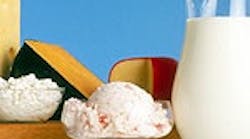Eating low-fat dairy products could lower your blood pressure, according to research reported June 26 in Hypertension: Journal of the American Heart Association.
Millions of Americans are affected by high blood pressure (HBP), and it is a major risk for stroke, heart attack, kidney failure and heart failure. HBP also incurs higher health care costs.
Non-drug approaches to lowering blood pressure include exercise, weight loss and the well-known Dietary Approaches to Stop Hypertension (DASH) diet, which is low in salt and rich in fruits, vegetables and low-fat dairy products. The DASH diet is also rich in the minerals potassium, magnesium and calcium, which are found in dairy products.
However, studies on calcium have had inconsistent results, with several showing no effect on blood pressure, said Luc Djoussé, M.D., M.P.H., D.Sc., lead author of the new study and an assistant professor of medicine at Harvard Medical School in Boston.
"We need to find other dietary factors that could help prevent the disease," said Djoussé, who is also an associate epidemiologist at Brigham and Women's Hospital in Boston.
He noted that although low-fat dairy products are considered beneficial, no conclusive studies explain why. That has caused scientists to wonder whether dairy's calcium content or some other unidentified components provide the apparent benefits.
"Dairy products, such as cheese, yogurt, and milk, are excellent sources of calcium," Djoussé said. "However, some dairy products also contain substantial amounts of saturated fat, which might offset some of the beneficial effects of dairy products. In this study, magnesium and potassium intake was associated with lower blood pressure, but calcium [intake] was not."
The researchers used data from food questionnaires from 4,797 men and women participants in the National Heart, Lung, and Blood Institute's Family Heart Study. Participants consisted of 45 percent men, 55 percent women with an average age of 52 years. Four percent of the participants were black. The goal of this multi-center, population-based study is to identify and evaluate genetic and non-genetic causes of coronary heart disease, atherosclerosis and cardiovascular risk factors, such as HBP.
"Our data showed that people who ate more dairy products had lower systolic blood pressure," Djoussé said.
Systolic blood pressure is the first (higher) number in a blood pressure reading; it indicates the pressure in the arteries when the heart beats. The lower (diastolic) number represents the pressure when the heart muscle is at rest between beats.
"Data from the Framingham Heart Study have shown that systolic blood pressure is a better predictor of cardiovascular disease in a dose-response fashion," Djoussé said. "This means the higher your systolic pressure, the higher your risk of cardiovascular disease."
Researchers divided participants into four groups based on their daily dairy intake. The highest dairy group said they ate more than three servings of dairy per day, while the lowest dairy group averaged less than half a serving of dairy per day. Systolic blood pressure was 2.6 millimeters of mercury (mm Hg) lower on average for people eating the most dairy than for those eating the least dairy.
When researchers divided the groups by those who ate below the average amount of saturated fat and those who ate above the average amount of saturated fat, the effects of high-dairy consumption on systolic blood pressure was only seen in people who ate below the average amount of saturated fat. In this group, those who ate the most dairy had a systolic pressure that was 3.5 mm Hg lower than those who ate the least dairy.
Furthermore, in a multivariable model that controlled for age, gender, education, energy intake, body mass index, alcohol consumption, history of coronary heart disease, diabetes and other variables, those who ate the most dairy had a 36 percent lower odds of having HBP than those who ate the least dairy.
Among participants who ate below the average amount of saturated fat, those who also ate the most dairy had 54 percent lower odds of HBP than those who ate the least amount of dairy.
"Our data showed that dairy consumption is inversely associated with prevalent high blood pressure and resting systolic blood pressure, mainly among individuals consuming less saturated fat and independent of the amount of dietary calcium," Djoussé said. "It is possible that nutrients other than calcium found in dairy products may be responsible for these findings."
In addition, people who reported eating the least amount of dairy products may have other dietary habits that account for their higher blood pressure. In this study, participants in the low-dairy group reported eating more butter, hot dogs, burgers and eggs than those in the higher dairy group, he said.
The cross-sectional design of this study limits the ability to draw a causal relationship between dairy consumption and blood pressure, he said, adding that further study is needed.
Editor's Note: Click here to read the abstract for Dr. Djoussé's study, titled "Influence of Saturated Fat and Linolenic Acid on the Association Between Intake of Dairy Products and Blood Pressure." The study's co-authors are James S. Pankow, Ph.D.; Steven C. Hunt, Ph.D.; Gerardo Heiss, M.D., Ph.D.; Michael A. Province, Ph.D.; Edmond K. Kabagambe, M.S., Ph.D.; and R. Curtis Ellison, M.D.


